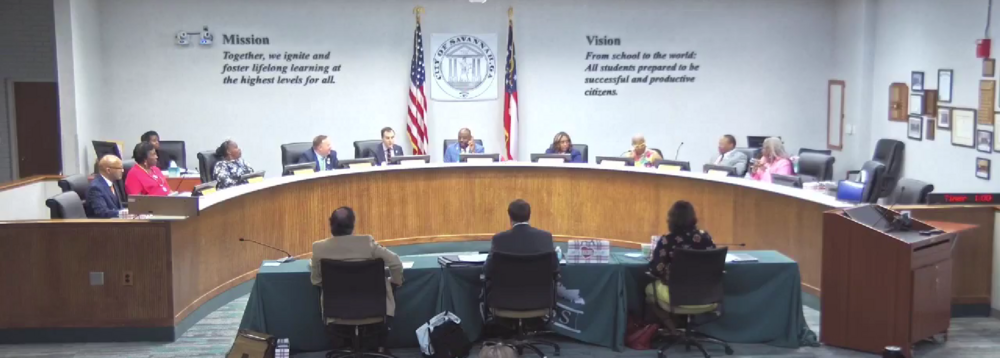
Caption
Members of Savannah City Council discuss a zoning ordinance at their meeting on March 27, 2025.
Credit: City of Savannah
LISTEN: The new zoning eases restrictions on how and where high-density housing can be built, particularly in neighborhoods long dominated by single-family homes. GPB's Benjamin Payne reports.

Members of Savannah City Council discuss a zoning ordinance at their meeting on March 27, 2025.
Savannah City Council approved an ordinance Thursday amending the city's zoning code to create what officials are calling an Affordable Housing Overlay District, a move aimed at addressing rising housing costs and increasing residential density.
The ordinance, which passed by a 7-2 vote with a minor modification, allows property owners to more easily develop high-density and multi-family housing in neighborhoods that have traditionally consisted of low-density, single-family homes.
However, all projects seeking affordable housing status must be certified by the city manager's office, which under the ordinance would be defined as residences in which rental or ownership costs do not exceed 30% of a household's gross income.
While the ordinance establishes the framework for the overlay district, it does not specify where it will be implemented. Instead, it outlines several zoning districts beyond downtown where it could be applied in the future.
Savannah Mayor Van Johnson described the measure as a necessary step toward increasing housing supply in the Hostess City.
"We can't complain about not having affordable housing if we're not willing to take the big, bold moves it’s going to take to get us there," Johnson said. "We have to create it, and it happens by density. And density has to be citywide."
The median rent in the Savannah metro area has increased by 55% since 2020, rising from $1,093 to $1,707, according to data from the U.S. Department of Housing and Urban Development.
"We've all heard — and continue to hear — from our neighbors across the city that housing prices remain unaffordable, and they're getting more unaffordable," Johnson said.
The stated purpose of the overlay district, as described in the ordinance, is "to increase housing availability, accessibility, and affordability options by encouraging the development of new housing opportunities that meet a broader range of needs and serve a more diverse population."
The vote followed multiple public hearings, which began in November, during which residents provided input on whether and how they would like to see their neighborhoods be included in the overlay district.
City Manager Jay Melder acknowledged that the policy change was unlikely to receive unanimous buy-in from impacted communities, but emphasized its potential to evolve based on continued feedback.
"This is really difficult work," Melder said. "We're not going to find 100% consensus on adding density as a way to solve the housing unit crisis. But, I think that starting somewhere is better than not starting at all. ... The elegance of what we're trying to achieve now is a program that can grow over time."
Before the final vote, City Council modified the ordinance to remove one type of single-family zoning district, known as RSF-6, from the overlay, effectively opting out the west Savannah neighborhood of Hudson Hill-Bayview.
The two dissenting votes came from Aldermen Nick Palumbo and Kurtis Purtee, both of whom voiced support for the original version of the ordinance without that modification.
Palumbo argued for an even distribution of affordable housing across Savannah, saying, "I'd rather share the burden with all of us, with a beautiful, walkable, dense place that we know and call and love [as] home, that millions of people the world over come and see and visit."
The ordinance also received support from community advocates in attendance at the meeting, including the Rev. Claire Marich of Justice Unites Savannah Together, an interfaith coalition representing more than 20 religious congregations in Savannah and Chatham County.
"We are strong supporters of this zoning text amendment," Marich told councilmembers ahead of their vote. "We feel that it is robust enough to make a difference and a dent in providing more housing [and] attainable housing for our residents, and yet it is moderate enough that it will not affect the overall character and quality of life in our city."
The next step for City Council will be to approve a map identifying the specific areas where the overlay district will be applied, a decision expected to come in a future meeting as early as April.